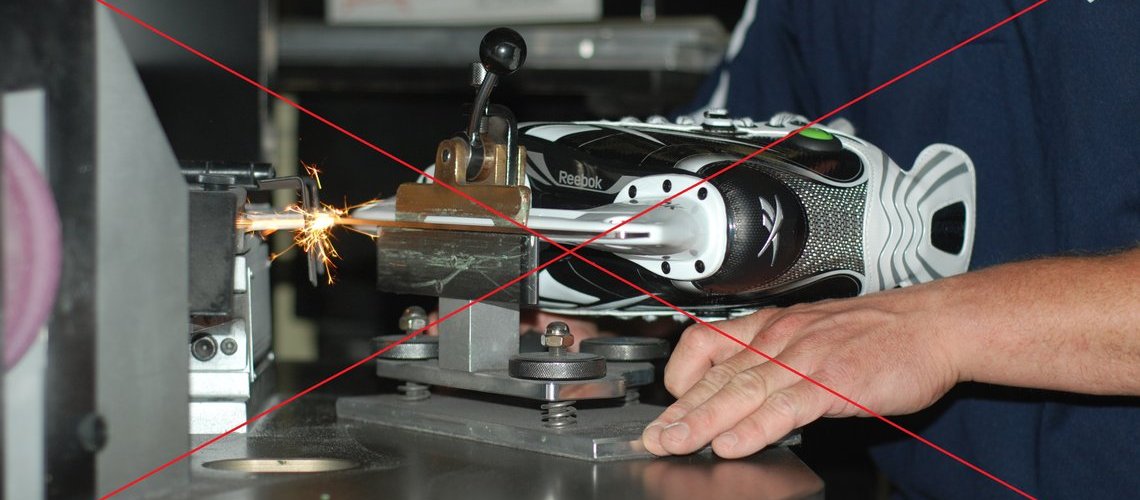


There is a misconception that the figure skating and ice hockey has a lot in common. And the truth, as in ice hockey and figure skating in the whole process takes place on the ice, and participants use the skates to get around the arena. In fact, just the same as the name of the key units of equipment - skates, and place of employment - the ice arena.
If you look closely it becomes apparent that the hockey and figure skating, do not like each other.
It all starts with the purchase of skates. Hockey player in 99% of cases of buying your skates in the collection form - shoes, glass for the blade and the blade itself (see photos 1), they are designed for his riding style, have a lot of options that a player identified as necessary for themselves. No matter what level of player, this process always remains so - buy whole package.
In figure skating, such kits also exist, but it is only at the initial stage. When an athlete goes to the next level, the shoes sold separately from the blade, due to the peculiarities of each skater and his skills.
After buying hockey skates, the owner comes into the workshop for sharpening and profiling blades. Together with the master they choose the first option (radius, area and groove) for the player and transfer those settings to the blade. After that hockey can sharpen your skates, where it is convenient and profitable, and when he feels that the desired settings are gone (often spoiled hand machines), it becomes a workshop where did profiling and sharpening after purchase. Usually is not any difficulty to recreate what has been done before!
After buying curly blades, the owner also applies to the shop. The master must check whether the blades are sharpened, sharpening whether this is suitable for the skaters and, if necessary, resharpen blade. Not what kind of profiling of the question! Pulling the blade out of the box they are fully prepared to work, all you have left to do is to sharpen them for yourself. But it Owned sharpening and lurking danger. Slidu Serviss, insists that all curly blades should be sharpened only on the semi-automatic equipment. Any type of manual sharpening equipment, already at the first grinding, can irreversibly change the blade profile than would entail major changes in the riding time, restore or convert shaped blades - it is impossible. The only working metod- replacement blades!
Figure blade has a few more features, compared to hockey blades. Hockey blade rounded at the ends, (photo 2) it makes no special manufacturers that would not stumble on the hockey angles they initially have a radius, and can additionally be ground off if necessary. Figure blade has front teeth, it is important that they are not carried out when Stoch sharpening. The teeth are very important for the skater and must remain intact throughout the cycle of use of the blades. Same As concerns heels, originally from the factory it is almost a straight line with an angle of 90 degrees. The same it should be and after sharpening.
Why Slidu Serviss workshops'm reccomend themselves use only the semi-automatic machines for sharpening blades curly? This is due to the fact that this type of equipment, allows to check all important parameters before beginning work and to applicable control all forces on the blade during sharpening. Namely,
Proven fact: Every 25-30 hours spent on the ice grinding wear out. To restore sharpness, sharpen the blade. In the process of sharpening the blade is removed from the steel, layer by layer. The front tooth is not sharpened and remains its size. The reference point (pivot point) with each sharpening moving higher and as a consequence of moving away from the front of the tooth as steel grinding. (Photo 3)
Important: Only when sharpening on a semi-automatic equipment, this shift is predictable. (Photo 4) Figure skater does not feel the changes to the sharpening of grinding, but there are changes, but they are minimal and controllable. Each subsequent time, this shift will be the same. Skater easily adapts to these changes. But as soon as you use manual equipment, control and predictability is lost. As a result, each sharpening, move the reference point erratically back and some skating time on existing blades become impossible. The first sign is the appearance of complexity with rotations.
Slidu Serviss strongly recommends the use of hand-held machines on blades for figure skating.
More information about the features of this profiling and-Trial can be found in the section "Profiling hockey blades"